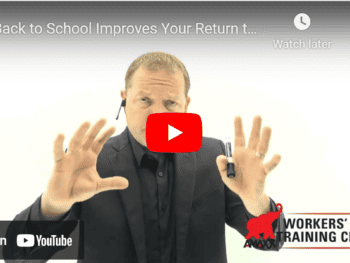
On the other hand, waiting to bring an employee back until he is 100 percent recovered prolongs the number of lost work days and impedes the worker’s recovery. Reinjuries, as well as extended disability durations both, add costs to the claim.
What’s needed is an accurate depiction of the physical requirements of a job, along with a deep understanding of exactly what the injured worker is physically able to do or not do. Armed with such information, the employer can make the best decisions for the injured worker and the organization.
Click Link to Access Free PDF Download
“13 Research Studies to Prove Value of Return-to-Work Program & Gain Stakeholder Buy-In”
ADA Considerations
One issue that may come into play when returning an injured worker is the Americans with Disabilities Act. Employers cannot refuse to let an employee return if he can perform the essential functions of that job — even if that requires reasonable accommodations.
Following return to work best practices will ensure compliance with the ADA. Return to work has even been described as the “ADA on steroids.”
Both return to work and the ADA involve a collaborative process between the employer, employee, and possibly, the medical provider. Whether the disability is work-related or not, the first question to ask is whether the person can do his original job.
In many cases, the worker may be able to perform the essential functions of the job with some modification or reasonable accommodation. That may involve an ergonomic change or schedule alteration, for example. As long as it does not impose undue hardship — either financially or operationally — on the employer, accommodations should be explored, both from a return to work and ADA standpoint.
Return to work best practices entail resuming work as soon as possible, both to help the worker heal and to reduce claim costs. A work accommodation or transitional duty that helps the worker get to the point where he/she can fully do the job is the best course of action.
If the worker cannot perform the essential functions of his job even with accommodations, providing a transitional job elsewhere within the company, or a position off-site would be the next step.
A key to ensuring compliance with the ADA and getting the best outcome from a return to work standpoint is to engage the employee in what is formally called the interactive process. This allows for an open and honest discussion about what the employee can do and how the employer can facilitate the process.
FREE DOWNLOAD: “13 Research Studies to Prove Value of Return-to-Work Program & Gain Stakeholder Buy-In”
Defensible Return to Work Solutions
There have been new tools developed that can accurately match a person’s physical capacity with specific jobs, allowing for a solid decision as to what the person is capable of doing, whether with reasonable accommodation or not.
An example is a digital job profiles integrated with automated job-matching analysis, developed by MyAbilities, combining ergonomic research with artificial intelligence-powered software that allows for ADA compliance and RTW best practices. It addresses the employee’s physical degree of fitness for the current job and runs those capabilities against all the digital profiles in a company’s job bank. If the injured worker is unable to perform his job, even with accommodation, the tool can identify other positions within the company that he might be capable of performing within his physical restrictions.
Digital job profiles comprehensively describe the physical requirements and features of every possible job. Each job includes graphics and video profiles, which significantly help evaluate and depict its physical requirements. The company’s automated physical assessment used in conjunction with the job-matching tools can quickly and accurately provide a picture of the worker’s physical capacity for various positions.
Under ADA law an employee is required, with or without accommodation, to perform the essential functions of a job achieving the same work product as other employees. However, this same stipulation does not apply under workers’ compensation RTW best practices which take ADA requirements a step further.
The job-matching tool allows employers to leverage the digital job profiles and interactive process to modify the employee’s original position with or without accommodation or provide an alternative transitional duty position. Exceeding ADA compliance requirements, this RTW best practice would be true even if the worker is unable to perform all of the essential functions of the job or their work product is less than comparable to other employees.
Conclusion
Getting injured employees back to work is a win-win for everyone — as long as the job involved is appropriate for the worker’s level of fitness. By collaborating with the injured worker and using sophisticated tools, such as the job-matching analysis developed by MyAbilities’ will ensure the best outcomes.

Author Michael Stack, CEO Amaxx LLC. He is an expert in workers’ compensation cost containment systems and helps employers reduce their workers’ comp costs by 20% to 50%. He works as a consultant to large and mid-market clients, is a co-author of Your Ultimate Guide To Mastering Workers Comp Costs, a comprehensive step-by-step manual of cost containment strategies based on hands-on field experience, and is founder & lead trainer of Amaxx Workers’ Comp Training Center.
Contact: mstack@reduceyourworkerscomp.com.
Workers’ Comp Roundup Blog: https://blog.reduceyourworkerscomp.com/
©2019 Amaxx LLC. All rights reserved under International Copyright Law.
Do not use this information without independent verification. All state laws vary. You should consult with your insurance broker, attorney, or qualified professional.















